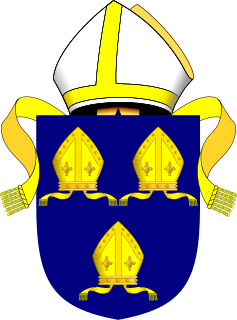Lyfing of Winchester was an Anglo-Saxon prelate who served as Bishop of Worcester, Bishop of Crediton and Bishop of Cornwall.
Leofric was a medieval Bishop of Exeter. Probably a native of Cornwall, he was educated on the continent. At the time Edward the Confessor was in exile before his succession to the English throne, Leofric joined his service and returned to England with him. After he became king, Edward rewarded Leofric with lands. Although a 12th-century source claims Leofric held the office of chancellor, modern historians agree he never did so.

Stigand was an Anglo-Saxon churchman in pre-Norman Conquest England who became Archbishop of Canterbury. His birth date is unknown, but by 1020 he was serving as a royal chaplain and advisor. He was named Bishop of Elmham in 1043, and was later Bishop of Winchester and Archbishop of Canterbury. Stigand was an advisor to several members of the Anglo-Saxon and Norman English royal dynasties, serving six successive kings. Excommunicated by several popes for his pluralism in holding the two sees, or bishoprics, of Winchester and Canterbury concurrently, he was finally deposed in 1070, and his estates and personal wealth were confiscated by William the Conqueror. Stigand was imprisoned at Winchester, where he died without regaining his liberty.

The Bishop of Norwich is the ordinary of the Church of England Diocese of Norwich in the Province of Canterbury. The diocese covers most of the county of Norfolk and part of Suffolk. The bishop of Norwich is Graham Usher.
Grimketel was an English clergyman who went to Norway as a missionary and was partly responsible for the conversion of Norway to Christianity. He initiated the beatification of Saint Olaf. On his return to England he became Bishop of Selsey and also for a time Bishop of Elmham. He was accused, by some, of being guilty of simony.
Ealdwulf was a medieval Abbot of Peterborough, Bishop of Worcester, and Archbishop of York.

The Bishop of Chichester is the ordinary of the Church of England Diocese of Chichester in the Province of Canterbury. The diocese covers the counties of East and West Sussex. The see is based in the City of Chichester where the bishop's seat is located at the Cathedral Church of the Holy Trinity. On 3 May 2012 the appointment was announced of Martin Warner, Bishop of Whitby, as the next Bishop of Chichester. His enthronement took place on 25 November 2012 in Chichester Cathedral.
Hædde was a medieval monk and Bishop of Winchester.
Merewith was an Anglo-Saxon Bishop of Wells. He was abbot of Glastonbury Abbey prior to being consecrated bishop about 1024. He died on either 11 April or 12 April 1033.
Duduc was a medieval Bishop of Wells.
Leofwin was a medieval Bishop of Lichfield.
Bifus or Bisi was a medieval Bishop of the East Angles.
Humbertus was a medieval Bishop of Elmham.
Ealdbeorht may have been a medieval Bishop of Dunwich.

Ælfhun was a medieval Bishop of Dunwich.

Æthelweald was a medieval Bishop of Dunwich.
Ælfgar was a medieval Bishop of Elmham.
Ealhstan was a medieval Bishop of Sherborne.
Ealdred was a medieval Bishop of Cornwall. He was consecrated between 981 and a period between 988 and 990. He died between 1002 and 1009.

Winchester Cathedral Priory was a cathedral monastery attached to Winchester Cathedral, providing the clergy for the church. Cenwealh son of Cynegils is credited with constructing the Old Minster of Winchester in the 640s, and a new bishopric was created in the 660s with Wine as the first bishop. Although attacked by the Vikings in 860 and 879, the monastery survived and recovered.






